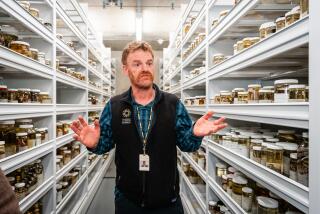Save the Earth’s ‘creepy-crawlies.’ Some of them just might save us

- Share via
When I was a child, I visited the village in India where my father grew up. As we strolled down dirt roads, he reminisced on his barefoot youth. I don’t remember much of what he said — I was too busy looking for reptiles in the shrubs. Later that day, we came upon a gaggle of children surrounding a snake. For a split moment, I felt like the luckiest kid in the world, elated to stumble upon my favorite animal in the wild. But the other kids didn’t share my joy. Instead, one of them beat it to death with a stick while the others celebrated. I broke down into tears.
Three decades later, I’m willing to forgive them. Each year, snakes kill 60,000 people across South Asia, and many more around the world. It’s entirely reasonable, even natural, to fear reptiles, but that fear has curdled into something nefarious. Eradication campaigns, combined with the pressures of habitat loss and climate change, have pushed global reptile populations to the brink; 1 in 5 reptile species now face imminent extinction. This is a moral, ecological and medical calamity. Reptiles and other frightful creatures have saved untold lives, and it would be a huge mistake to hasten their demise.
The world’s “creepy-crawlies” are responsible for some of the most consequential pharmaceutical breakthroughs of the past century. ACE inhibitors, a first-line treatment for high blood pressure, were derived from the venom of the yarara, a 5-foot-long pit viper native to South America. In the ’60s, researchers noticed that workers on local banana plantations would faint when bitten by the snake, a sign of rapid-onset hypotension. By 1981, researchers had isolated the pressure-dropping compound from its venom, created a synthetic formulation, and won regulatory approval for captopril, which became the pharmaceutical company Squibb’s first billion-dollar drug. As an internal medicine doctor, I have administered this exact medicine to countless patients; worldwide, 20 million people rely on this class of drugs, known as ACE inhibitors, to avoid heart attacks and chronic kidney disease. They are a medical miracle.
Federal funding for obscure reptile research can pay big dividends. In the 1990s, the United States Department of Veterans Affairs financed a study of gila monsters, hoping to understand how these venomous lizards go for long periods without food but maintain stable blood sugar levels. The investigation led to a remarkable discovery: Gila monster venom contains a peptide that stimulates insulin production. That’s how scientists eventually synthesized GLP-1 agonists like semaglutide (which are sold under the brand names Ozempic and Wegovy), which have revolutionized diabetes management and weight loss, while demonstrating other positive clinical effects across the body.
The modern pharmaceutical industry has long been powered by nature, and there’s no signs of this changing — even as artificial intelligence transforms drug development. One-third of all small-molecule drugs approved by the Food and Drug Administration from 1981 to 2014 were derived from naturally occurring compounds, forged by the great furnace of evolution. Recombinant hirudins, for example, are a class of medicines used to treat patients with allergies to traditional anti-clotting drugs; they originated in the salivary glands of blood-sucking leeches. Snails may hold the secret to new painkillers that don’t possess the addictive qualities of opiates. Enzymes derived from deep-sea bacteria have been used to make tests for COVID-19. The most undervalued creatures often hold the most miraculous secrets, but we won’t untangle those mysteries without protecting neglected species, preserving research funding and partnering with the communities who live closest to nature.
We can’t study animals if there are no animals left to study. The planet is in the midst of a mass extinction event, precipitated by human actions. In the last 50 years, nearly 75% of wildlife populations have declined. To save what’s left of nature, governments must follow through on their 2022 commitment to conserve 30% of the world’s land and sea by 2030, an initiative known as “30x30.”
The U.S. government must also reverse its short-sighted policies that are cutting research funds. Scientific inquiry, no matter how strange-sounding or unfamiliar, is rarely “wasteful” or “frivolous.” Federal funding for big, out-there ideas has led to breakthrough discoveries like mRNA vaccines. Often, the most transformational research begins with an unusual grant proposal, probably deemed too risky for private funding. When scientists are empowered to follow their curiosity, everyone benefits — but somebody has to be willing to take a chance on them. If we stop investing in medical research today, we forgo the life-saving discoveries of tomorrow.
Scientists, for their part, must open themselves up to new partnerships and perspectives. In remote corners of the world, communities possess tremendous knowledge of local flora and fauna, but few medical researchers from academia or the healthcare industry have ever bothered to ask them about it. Many of these communities are reasonably skeptical of outside researchers, who have been known to patent traditional remedies without compensating the original source of knowledge, a practice known as “biopiracy.” It’s long past time to bridge that gap — between science and tradition, Global North and Global South — and cooperate in a mutually beneficial way.
We all have something to learn from these communities, not just about healing, but about coexistence. This Earth Day, may we all resolve to admire the exquisite variety of life on this planet; meet the strange and fearsome with curiosity rather than revulsion; and remember that we are one small part of nature, rather than masters of it. All living things on this planet are connected, our fates all intertwined. Saving the world’s reptiles isn’t merely an act of altruism — it’s an act of self-preservation.
Neil M. Vora is a practicing physician, a senior advisor at Conservation International and the executive director of the Preventing Pandemics at the Source Coalition.
More to Read
Insights
L.A. Times Insights delivers AI-generated analysis on Voices content to offer all points of view. Insights does not appear on any news articles.
Perspectives
The following AI-generated content is powered by Perplexity. The Los Angeles Times editorial staff does not create or edit the content.
Ideas expressed in the piece
- The article emphasizes the critical role of reptiles and other misunderstood species in medical breakthroughs, citing examples such as ACE inhibitors derived from snake venom and GLP-1 agonists like Ozempic originating from Gila monster research[1][2]. These discoveries underscore the value of preserving biodiversity for human health.
- Neil Vora advocates for the 30x30 initiative, urging governments to conserve 30% of Earth’s land and sea by 2030 to mitigate mass extinction driven by habitat loss and climate change[1][3]. He frames conservation as both an ecological necessity and a form of “self-preservation” for humanity.
- The piece highlights the importance of federal funding for unconventional research, noting that studies on obscure species have led to transformative drugs like mRNA vaccines. Vora argues that cutting such funding jeopardizes future discoveries[1][2].
- Collaboration with Indigenous communities is presented as essential to combating “biopiracy” and leveraging traditional knowledge for ethical drug development. Vora stresses the need for mutual respect between researchers and local populations[3].
Different views on the topic
- Fear-driven eradication campaigns against snakes and other “dangerous” species persist globally, reflecting a prioritization of immediate human safety over long-term ecological balance. This approach is rooted in the real-world impact of snakebites, which kill tens of thousands annually in South Asia[1][2].
- Skepticism toward conservation efforts exists in some communities, particularly where human-wildlife conflict is acute. For example, educational challenges in the Philippines reveal resistance to crocodile preservation efforts, as locals prioritize safety and economic needs over species protection[3].
- While not explicitly opposing conservation, historical exploitation of Indigenous knowledge (“biopiracy”) has fueled distrust of outside researchers, complicating efforts to bridge scientific and traditional practices. This tension underscores the difficulty of achieving equitable partnerships[3].
A cure for the common opinion
Get thought-provoking perspectives with our weekly newsletter.
You may occasionally receive promotional content from the Los Angeles Times.






